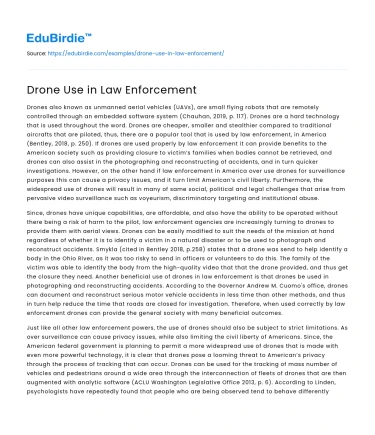Drones also known as unmanned aerial vehicles (UAVs), are small flying robots that are remotely controlled through an embedded software system (Chauhan, 2019, p. 117). Drones are a hard technology that is used throughout the word. Drones are cheaper, smaller and stealthier compared to traditional aircrafts that are piloted, thus, there are a popular tool that is used by law enforcement, in America (Bentley, 2018, p. 250). If drones are used properly by law enforcement it can provide benefits to the American society such as providing closure to victim’s families when bodies cannot be retrieved, and drones can also assist in the photographing and reconstructing of accidents, and in turn quicker investigations. However, on the other hand if law enforcement in America over use drones for surveillance purposes this can cause a privacy issues, and it turn limit American’s civil liberty. Furthermore, the widespread use of drones will result in many of same social, political and legal challenges that arise from pervasive video surveillance such as voyeurism, discriminatory targeting and institutional abuse.
Since, drones have unique capabilities, are affordable, and also have the ability to be operated without there being a risk of harm to the pilot, law enforcement agencies are increasingly turning to drones to provide them with aerial views. Drones can be easily modified to suit the needs of the mission at hand regardless of whether it is to identify a victim in a natural disaster or to be used to photograph and reconstruct accidents. Smykla (cited in Bentley 2018, p.258) states that a drone was send to help identify a body in the Ohio River, as it was too risky to send in officers or volunteers to do this. The family of the victim was able to identify the body from the high-quality video that that the drone provided, and thus get the closure they need. Another beneficial use of drones in law enforcement is that drones be used in photographing and reconstructing accidents. According to the Governor Andrew M. Cuomo's office, drones can document and reconstruct serious motor vehicle accidents in less time than other methods, and thus in turn help reduce the time that roads are closed for investigation. Therefore, when used correctly by law enforcement drones can provide the general society with many beneficial outcomes.
Save your time!
We can take care of your essay
- Proper editing and formatting
- Free revision, title page, and bibliography
- Flexible prices and money-back guarantee
Just like all other law enforcement powers, the use of drones should also be subject to strict limitations. As over surveillance can cause privacy issues, while also limiting the civil liberty of Americans. Since, the American federal government is planning to permit a more widespread use of drones that is made with even more powerful technology, it is clear that drones pose a looming threat to American’s privacy through the process of tracking that can occur. Drones can be used for the tracking of mass number of vehicles and pedestrians around a wide area through the interconnection of fleets of drones that are then augmented with analytic software (ACLU Washington Legislative Office 2013, p. 6). According to Linden, psychologists have repeatedly found that people who are being observed tend to behave differently, and make different decisions, compared to when they are not being watched. Thus, in turn when the government observe everyone through the use of drones when they are out and about in the public it not only an invasion of privacy, it also limits the American public’s civil liberty as they don’t freely act in the public.
In addition, to the privacy issues and civil liberty restrains that results from the over use of drones in surveillance they raise many of the same issues that pervasive video surveillance does. Voyeurism is a social challenge that happens has a result of pervasive surveillance. According to the New York Times, in 2004 a New York police helicopter recorded a couple having sex on a rooftop balcony using night vision during a dark nighttime for about four minutes. Instead, of taking responsibility for this abuse of power, the New York Police Department said they were doing this to make sure that they were not doing anything illegal. Another social challenge that can happen, involves discriminatory targeting as those who are operating surveillance systems bring to their job any existing prejudices and biases they may have. These prejudices and biases, then in turn results in certain groups of people undergoing disproportionate surveillance. According to Norris and Armstrong, this was the case in Great Britain, where people of color were between one-and-a-half and two and-a-half times more likely to be surveilled than the one would expect from their presence in the general population. Institutional abuse is both a political and legal challenge that arises, from there being bad policies set during periods of intense political conflict and social turmoil. An example of this includes the increase spying against peaceful political protestors that happens across America (ACLU Washington Legislative Office 2013, p.8). These challenges that that result from abuse of power by the inevitable ‘bad apples’ that are present within law enforcement, as well as institutional abuse could become something common, if drone technology enters widespread use.
In the hands of law enforcement, drones can be used for both innocuous purposes as well as invasive purposes. However, if drones are used only in proportionate and when it is necessary by law enforcement the negative impacts it causes on the privacy and civil liberty of Americans, as well as the social, political and legal challenges that arise from widespread use of drone technology can be easily addressed.






 Stuck on your essay?
Stuck on your essay?

